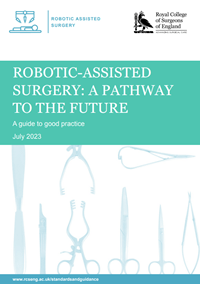Robotic-assisted surgery: A pathway to the future

Since the introduction of robotic-assisted surgery (RAS) in the UK in the late 1990s, more than 12 million robotic-assisted procedures have been performed in more than 70 countries. In 2022 alone there were over 1.8 million procedures and the numbers are rapidly rising.
As part of the College’s commitment to ensuring high standards for surgery and patient care, we have produced new guidance on robotic-assisted surgery, which addresses the challenges and the promises of RAS, and provides recommendations on its safe adoption and sustainable expansion in the UK.
Who is this guide for?
This guide is intended for service planners, surgeons, all members of the surgical team, medical and clinical directors and regulatory bodies.
What can I learn from this guide?
The guide provides a broad framework for the safe adoption and sustainable expansion of robotic assisted surgery, including:
- a structured training pathway for established surgeons, leading to independent practice in robotic-assisted surgery
- sound governance practices
- roles and responsibilities of key stakeholders, including regulators, hospitals, surgeons and industry
It makes specific recommendations in the following areas:
- minimum requirements for robotic skills training
- how to determine competence and proficiency
- how to develop the robotic surgical team
- how to introduce RAS into surgical services, including an outline of the roles and responsibilities of all key stakeholders involved in the successful introduction and governance of the programme (hospitals, surgeons, proctors, robotic companies, regulators)
- selection of suitable cases for robotic surgery
- the process of consent
- managing conflicts of interest
- maintaining an accessible register of proctors
- mentoring arrangements
 Download Robotic-assisted surgery: A pathway to the future.
Download Robotic-assisted surgery: A pathway to the future.
Want to learn more about surgical innovation and technology?
- Read Surgical Innovation, new techniques and technologies guidance.
- Visit the Future of Surgery site to find the Future of Surgery report and Technology Enhanced Surgical Training (TEST) report.
